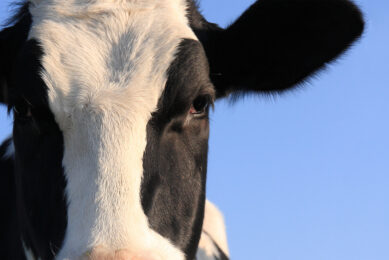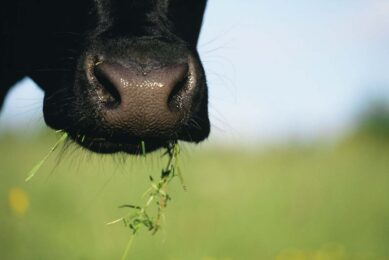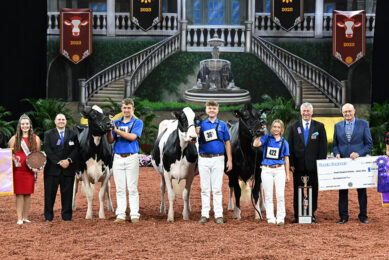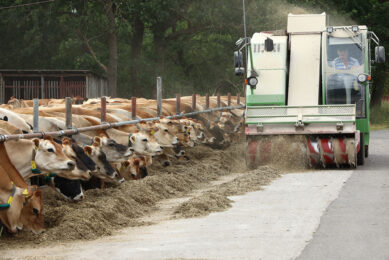Embryo transfer of Holsteins takes off in Russia
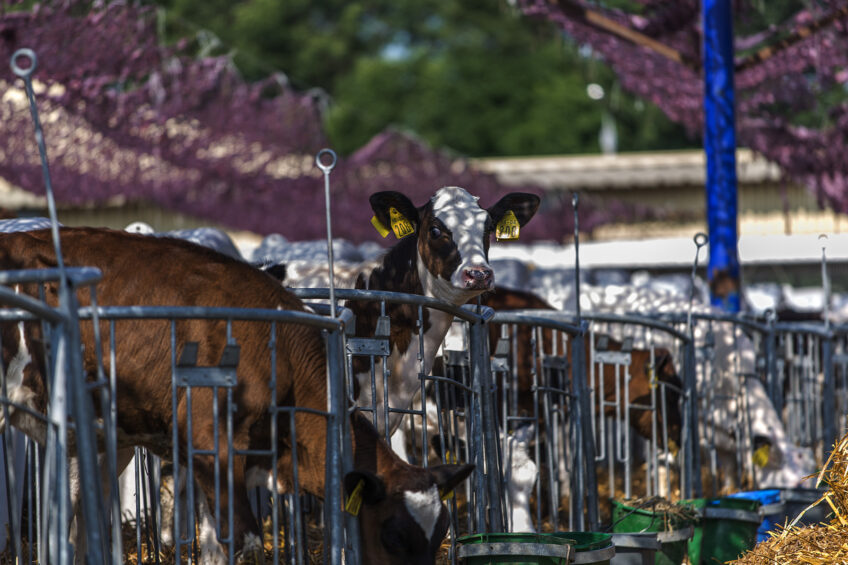
The Russian dairy industry may soon benefit from embryo transfer of Holsteins, a cheaper alternative than importing Holstein cattle into the country. The Kuban Agro project aims to increase the use of this breeding technique.
Andrey Oleynik, chairman of the board of directors of Kuban Agro, explains that around 60% of breeding cattle and 80% of bovine semen used by Russian farmers is imported. In a situation when the rouble slumped by almost 100% against the euro, prices for import have increased at least two fold. “Hit by the economic crisis, national currency devaluation and increased interest rates, Russian agribusiness is anxiously looking for alternative options for importing expensive cattle,” Oleynik explains.
Kuban Agro indicates that in general embryo transfer technology is gaining interest among Russian dairy farmers because it is twice as cheap as importing dairy heifers. Moreover, it does not incur any logistic cost related to shipment of heifers from abroad. “Herd replacement can be done in three ways: artificial insemination, import of heifers and embryo transfer. Artificial insemination is the least productive way to renew the herd as one cow gives birth to only one calf annually,” Oleynik says. In his opinion, the heifer market in Russia is traditionally very tight. Farmers usually keep the highest quality cows for themselves and sell the less quality cows. He adds: “When we import heifers, all we have are the documents that claim their ancestors produced well. But we never know all the details of the cows’ genetic background. Embryo transfer is the most reliable and efficient technology that allows us to produce 10-20 Holstein calves per one cow of any breed.”

Animal breeding and genomics center in 2017
In 2014, Kuban Agro opened its Embryo Biotechnology Center in Ust-Labinsk, a city in Russia’s southern Krasnodar Krai. “One of the main partners in this is our subcontractor Scientific and Production Center for Biotechnology and Embryo Transfer, based in the Moscow region. Specialists from the scientific centre helped our staff to flush embryos and transfer them to recipient cows. We have also attracted Stephen Townsend, a British specialist in embryo flushing and transfer,” Oleynik explains.
The company invested 25 million roubles ($800,000 at the exchange rate in 2014) of its own funds, which were spent on breeding bull semen, embryo flushing and transfer services and laboratory equipment. Ten people work at the centre. Among the centre’s short-term plans is to create an animal breeding and genomics centre in 2017, which will serve as a supplier of dairy herd to Kuban Agro and to the market. The company is planning to sell its home-made breeding heifers to other agricultural companies. According to Kuban Agro’s management, the quick implementation of embryo transfer is important for Russia, as dairy farmers are still struggling with the economic situation and the weakness of the rouble. In addition, this will reduce Russia’s dependence on US and Canada. Oleynik adds that the main stumbling block behind the development of embryo transfer in Russia is the outdated legislation on livestock breeding. “The legislation does not recognise transplant calves born through embryo transfer as pedigree ones. At the moment, Kuban Agro is actively lobbying reforms that would give a green light to the development of breeding cattle through embryo transfer,” Oleynik adds.
About Kuban Agro
Kuban Agro is one of the biggest companies in the agricultural sector in Russia. It is part of the diversified industrial group Basic Element. The main activities of the company are: animal industry, seed production, sugar production, grain processing and storage and seed production. Kuban Agro consists of 11 commercial dairy farms, a meat-processing complex, a pig-breeding farm, grain elevators, factories for seed production and processing, Svoboda sugar factory and Voskhod stud farm. There are 5,000 people working in Kuban Agro. The company’s revenue increased to 10.1 billion roubles ($144 million), 2.8 billion roubles ($40 million) more year-on-year, net profit reached 2 billion roubles ($29 million) in 2015, which is 600 million roubles ($8.5 million) higher year-on-year.
The keys to success
Oleynik explains that embryo transfer traditionally consists of four basic steps, starting with selection of the donor cow, followed by superovulation, insemination and lastly, the flushing and transfer. “The first step is the selection of the donor cow. Dairy cattle are selected according to one major trait: milk production. The potential donor cow should be reproductively sound to produce maximal results. This means that she should have a normal reproductive tract on rectal palpation and have a normal postpartum history,” Oleynik explains. It is also important that the cows have a desirable body condition score at the time of embryo transfer. In the next phase, superovulation, the cow releases multiple eggs at a single oestrus. Cows or heifers properly treated can release as many as 10 or more viable egg cells at one oestrus.

According to Oleynik, approximately 85% of all normal fertile donors will respond to superovulation treatment with an average of five transferable embryos. Some cows are repeatedly treated at 60-day intervals with a slight decrease in embryo numbers over time. The donor animal is then inseminated with semen from the breeding bulls. One bull can be used or semen from multiple bulls can also be used to impregnate the cow. Seven days after insemination, the cows are flushed and the embryos are collected. This is done by a small synthetic rubber catheter, which is inserted through the cervix of the donor cow. A special medium is flushed in and out of the uterus to harvest the embryos. When this is completed, embryos are examined under a microscope and then either transferred to recipient animals or frozen and stored in liquid nitrogen for later transfer into recipient animals. Recipient animals also form an integral part of the success of an embryo transfer program and have to be managed carefully to ensure as many pregnancies as possible result from the embryo transfer.
Another important part of the success is testing the genetics. “Russia is still lagging behind in terms of cattle genomic testing. Together with Scientific and Production Center for Biotechnology and Embryo Transfer and Moscow State University, we are therefore planning to start cattle genetic testing. It gives a snapshot of the genetic makeup of an animal and identifies cows’ production characteristics (milk, fat and protein yield), conformation (udder, legs and capacity) and health conditions (somatic cell score, fertility etc). Genetic profiling of heifers also provides a powerful genetic basis for the many breeding, selection and marketing decisions,” Oleynik explains.
Over 2,000 embryos flushed
Holstein cows are one of the most popular breeds among Russian farmers. According to the latest data (1 January 2015) from the Russian Research Institute of Animal Breeding, there are nearly 278,000 heads of Holstein cattle including 176,610 cows in Russia. In the Krasnodar region, where Kuban Agro operates, Holstein cows are the third most popular (equivalent to around 27.3% of the dairy herd population) after the Black-and-White (30.7%) and Red Steppe Breed (27.9%). According to Oleynik, embryo transfer technology, used by the company over the last two years, has already proven its feasibility.
“Since the opening of the Embryo Biotechnology Center in Ust-Labinsk in 2014, Kuban Agro has received 478 transplant calves including 233 dairy heifers from nearly 400 Holstein donor cows. In December 2014, Kuban Agro celebrated the birth of the first transplant heifer Zhuravushka which will give birth to its first calf in October-November 2016,” Oleynik says. Over 2,000 embryos have been flushed from donor Holsteins since 2014. Some of them have been frozen, while the remainder have been implanted to 1,211 Ayrshire cows resulting in 649 pregnancies. The embryo transfer technique will also help in reducing the culling rate in Russia. The company estimates that cattle culling rates in Russia range from 18% to 35% per annum, due to udder problems, death or slaughter.
“This means that up to 35% of the dairy herd population should be replaced every year. Kuban Agro’s annual culling rate stands at 25%. We are planning to fully replace culled cows with our own Holstein transplant cows by 2018. With our current 8,688-head dairy herd, this means that we will be replacing over 2,000 cows every year starting from 2018. This is our main target in terms of development of embryo transfer technology at Kuban Agro, Oleynik concludes.
Join 13,000+ subscribers
Subscribe to our newsletter to stay updated about all the need-to-know content in the dairy sector, two times a week.



